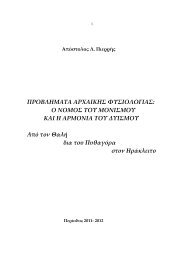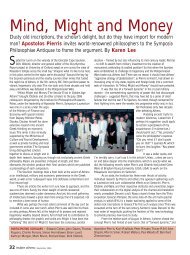APPENDIX C΄ ON DEPILATION: BODY COSMETICS IN CLASSICAL ...
APPENDIX C΄ ON DEPILATION: BODY COSMETICS IN CLASSICAL ...
APPENDIX C΄ ON DEPILATION: BODY COSMETICS IN CLASSICAL ...
You also want an ePaper? Increase the reach of your titles
YUMPU automatically turns print PDFs into web optimized ePapers that Google loves.
<strong>ON</strong> DEPILATI<strong>ON</strong>: <strong>BODY</strong> <strong>COSMETICS</strong> <strong>IN</strong> <strong>CLASSICAL</strong> ANTIQUITY 569<br />
considered Ï¢ÎfiÙ˘ in body (naturally of the athletic, marble-like<br />
nature) as sign of particular valour, then, given the close association<br />
between Ï¢ÎfiÙ˘ and ÏÂÈfiÙ˘ (for partly Ï¢ÎfiÙ˘ is the result of the<br />
absense of any hairiness and of the glistening quality of skin in a<br />
healthy body), we can better understand how it came to be that it was<br />
precisely the austere Spartans who abundantly practised depilation<br />
and had clearly shown an exquisite taste for a beautiful skin in the<br />
male body (another associated contributory factor was, of course, their<br />
strong Dorian homosexual proclivity). Cf. Apollonius, Epistola LXIII<br />
to the Spartan Ephors and the Lacedaemonians generally in answer to<br />
the public honour rendered by them to him. They sent the official<br />
testimony of that honour by some envoys respecting which Apollonius<br />
writes: ôÓ‰Ú·˜ ñÌáÓ âı·ۿÌËÓ ñapple‹ÓËÓ Ìc ö¯ÔÓÙ·˜, ÙÔf˜ ÌËÚÔf˜<br />
ηd Ùa ÛΤÏË Ï›Ԣ˜ Ù ηd Ï¢ÎÔ‡˜, etc. (cf. Philostratus, Vita<br />
Apollonii, IV, 27). It is true that Apollonius and Philostratus (as so<br />
many other authors, mainly modern) associate this smoothness and<br />
brilliance with effeminate weakness and luxurious softness. But, as I<br />
have said, this is not necessarily the case. The error is of the same type<br />
as that committed in the prevailing Modern-European confusion and<br />
virtual identification of homosexuality and effeminacy. To correct such<br />
a faulty notion, one may begin by simply consulting Juvenal, II, 9 sqq.<br />
(in the Satura de philosophis obscenis as has it the chief ms. P):<br />
----------- Castigas turpia, quum sis<br />
inter Socraticos notissima fossa cinaedos.<br />
Hispida membra quidem et durae per brachia saetae<br />
promittunt atrocem animum; sed podice levi<br />
caeduntur tumidae, medico ridente, mariscae.<br />
Something similar (without, of course, the satirist’s exaggeration)<br />
probably was not uncommon with the Lacedaemonians. We know<br />
what a keen interest they took in beautiful, manly, well-built bodies.<br />
Cf. e.g. Aelian, Varia Historia, XIV, 7; the source is Agatharchidas, v.<br />
Athenaeus, XII, 550c sqq. Athenaeus does not mention anything<br />
about the tint of the skin of the young Spartans. The Ephors caused<br />
them to appear nude before them to check how well they were built<br />
(Ùe Û¯ÉÌ·) and whether they betrayed any tendency to corpulence<br />
(ÙeÓ ùÁÎÔÓ ÙÔÜ ÛÒÌ·ÙÔ˜). When Aelianus, therefore, says Mˉ¤Ó·










